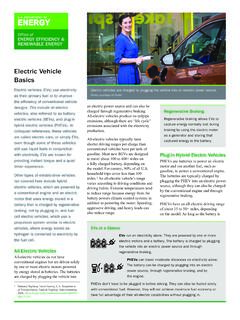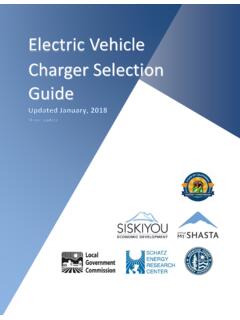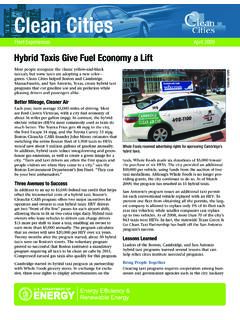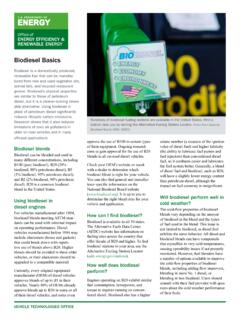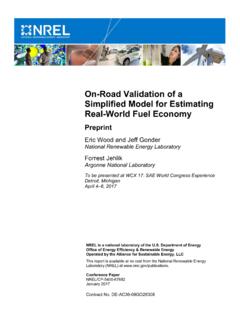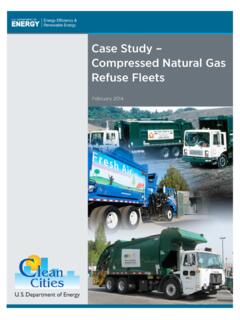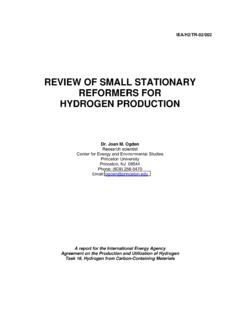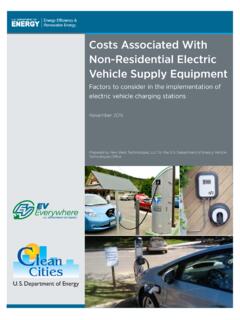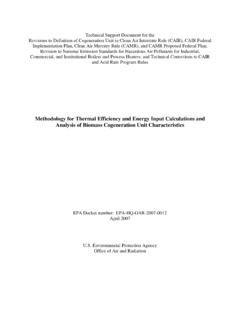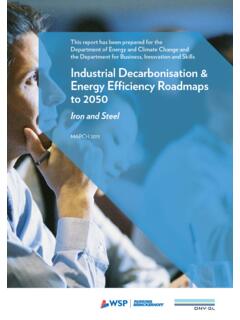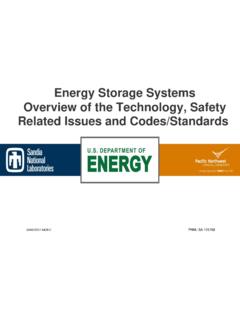Transcription of Emissions Associated with Electric Vehicle ... - Energy
1 NREL is a national laboratory of the Department of Energy Office of Energy efficiency & Renewable Energy Operated by the Alliance for Sustainable Energy , LLC This report is available at no cost from the National Renewable Energy Laboratory (NREL) at Contract No. DE-AC36-08GO28308 Emissions Associated with Electric Vehicle Charging: Impact of Electricity Generation Mix, Charging Infrastructure Availability, and Vehicle Type Joyce McLaren, John Miller, Eric O Shaughnessy, Eric Wood, and Evan Shapiro National Renewable Energy Laboratory Technical Report NREL/TP-6A20-64852 April 2016 NREL is a national laboratory of the Department of Energy Office of Energy efficiency & Renewable Energy Operated by the Alliance for Sustainable Energy , LLC This report is available at no cost from the National Renewable Energy Laboratory (NREL) at Contract No.
2 DE-AC36-08GO28308 National Renewable Energy Laboratory 15013 Denver West Parkway Golden, CO 80401 303-275-3000 Emissions Associated with Electric Vehicle Charging: Impact of Electricity Generation Mix, Charging Infrastructure Availability, and Vehicle Type Joyce McLaren, John Miller, Eric O Shaughnessy, Eric Wood, and Evan Shapiro National Renewable Energy Laboratory Prepared under Task No. Technical Report NREL/TP-6A20-64852 April 2016 NOTICE This report was prepared as an account of work sponsored by an agency of the United States government. Neither the United States government nor any agency thereof, nor any of their employees, makes any warranty, express or implied, or assumes any legal liability or responsibility for the accuracy, completeness, or usefulness of any information, apparatus, product, or process disclosed, or represents that its use would not infringe privately owned rights.
3 Reference herein to any specific commercial product, process, or service by trade name, trademark, manufacturer, or otherwise does not necessarily constitute or imply its endorsement, recommendation, or favoring by the United States government or any agency thereof. The views and opinions of authors expressed herein do not necessarily state or reflect those of the United States government or any agency thereof. This report is available at no cost from the National Renewable Energy Laboratory (NREL) at Available electronically at SciTech Connect Available for a processing fee to Department of Energy and its contractors, in paper, from: Department of Energy Office of Scientific and Technical Information Box 62 Oak Ridge, TN 37831-0062 OSTI Phone: Fax: Email: Available for sale to the public, in paper, from: Department of Commerce National Technical Information Service 5301 Shawnee Road Alexandria, VA 22312 NTIS Phone: or Fax: Email: Cover Photos by Dennis Schroeder: (left to right) NREL 26173, NREL 18302, NREL 19758, NREL 29642, NREL 19795.
4 NREL prints on paper that contains recycled content. iii This report is available at no cost from the National Renewable Energy Laboratory (NREL) at Acknowledgments This work was funded by the Department of Energy s Vehicle Technologies Program as part of the Workplace Charging Challenge initiative. The authors would like to thank the following individuals for their valuable contributions and reviews: Wendy Dafoe, David Hurlbut, Caley Johnson, Venkat Krishnan, Trieu Mai, Marc Melaina, Margo Melendez, Chris Nelder, Jeremey Newbauer, Joshua Novacheck, Matthew O Connell, Emerson Reiter, and Jake Ward. The authors are solely responsible for any omissions or errors contained herein. iv This report is available at no cost from the National Renewable Energy Laboratory (NREL) at Abstract With the aim of reducing greenhouse gas Emissions Associated with the transportation sector, policymakers are supporting a multitude of measures to increase Electric Vehicle adoption.
5 The actual amount of Emissions reduction Electric vehicles provide is dependent on when and where drivers charge the vehicles. This analysis contributes to our understanding of the degree to which a particular electricity grid profile, the Vehicle type, and charging patterns impact CO2 Emissions from light-duty, plug-in Electric vehicles. We present an analysis of anticipated Emissions resulting from both battery Electric and plug-in hybrid Electric vehicles for four charging scenarios and five electricity grid profiles. A scenario that allows drivers to charge Electric vehicles at the workplace yields the lowest level of Emissions for the majority of electricity grid profiles. However, Vehicle Emissions are shown to be highly dependent on the percentage of fossil fuels in the grid mix, with different Vehicle types and charging scenarios resulting in fewer Emissions when the carbon intensity of the grid is above a defined level.
6 Restricting charging to off-peak hours results in higher total Emissions for all Vehicle types, as compared to other charging scenarios. v This report is available at no cost from the National Renewable Energy Laboratory (NREL) at Table of Contents Introduction and Background .. 1 Methodology .. 3 Electricity Grid Profiles .. 3 Calculating Electrical Load from EV Charging .. 4 Calculating Emissions Associated with the Scenarios .. 6 Electricity Load Profiles Associated with EV Charging .. 8 Analysis of Emissions Associated with Miles Driven on Electricity .. 10 Emissions Associated with Non-Electricity Miles .. 16 Total Emissions Results: Emissions from Electric + Non- Electric Miles.
7 16 Sensitivity Analysis .. 20 Conclusions .. 24 References .. 26 1 This report is available at no cost from the National Renewable Energy Laboratory (NREL) at Introduction and Background With the aim of reducing greenhouse gas Emissions Associated with the transportation sector, decision makers at the national, state, and local levels are supporting a multitude of policy measures to increase adoption of light-duty Electric vehicles ( DOE 2015; DeShazo 2015; ICCT 2015; Zhou 2015). The actual emission-reduction benefits Associated with plug-in Electric vehicles (PEVs) in a specific location are dependent on multiple factors, such as the electricity generation fuel mix, the time of day charging, and the Vehicle type.
8 Using a wide variety of methodologies and assumptions, numerous studies have investigated the impact of these different factors on Emissions (Hacker 2007; Parks 2007; Anaire 2012; Kelly 2012; RAP/ICCT 2013; Nunes 2014; Tulpule 2014; Nealer 2015; Wood 2015; Jochem 2016). A 2012 Union of Concerned Scientists (UCS) study concludes that Emissions from Electric vehicles are less than those of an average conventional Vehicle , regardless of mix of fuels used to generate the electricity on which they are charged (Anair 2012). While the authors of the study acknowledge the impact of location and time of day that charging occurs, they do not specifically calculate PEV Emissions for different grid mixes, stating: Because the hourly variations in Emissions intensity are not consistent across regions, times of day, or seasons, it is not practical to develop general consumer guidelines on when the lowest Emissions intensity will occur throughout the day.
9 For now, we recommend that EV consumers use their regional grid Emissions , averaged over the course of the year, as a guide to estimating their personal EV global warming Emissions . Several studies have quantified the importance of location and time of day when estimating PEV Emissions . Tulpule (2013) concludes that day charging with solar-powered charging stations in Ohio could realize CO2 Emissions reductions of up to 90% versus home charging during evening hours. Jochem et al . (2015) finds that total life-cycle external costs of PEVs are highly dependent on the electricity mix and the charging strategy employed. While a commonly used methodology bases Emissions estimates on the annual average electricity generation mix (Hacker 2007), an alternative approach bases calculations on the electricity fuel source that is on the margin (meaning the electricity load that PEVs add to the existing load).
10 1 Holland et al . (2015) take this approach, finding significant variation in the marginal Emissions Associated with P EVs in different locations, thus reinforcing the notion that electricity grid mix has a notable impact on Emissions . The authors also point out the potential for the transfer of the Emissions benefits of EVs from one location to another, as a result of regional electricity imports and exports. Parks et al . ( 2007) and Denholm et al. (2013) also use the marginal emission methodology. Both studies conclude that the availability of daytime charging increases the percentage of miles that plug-in hybrid Electric vehicles (PHEVs) drive on electricity and results in greater petroleum displacement.

